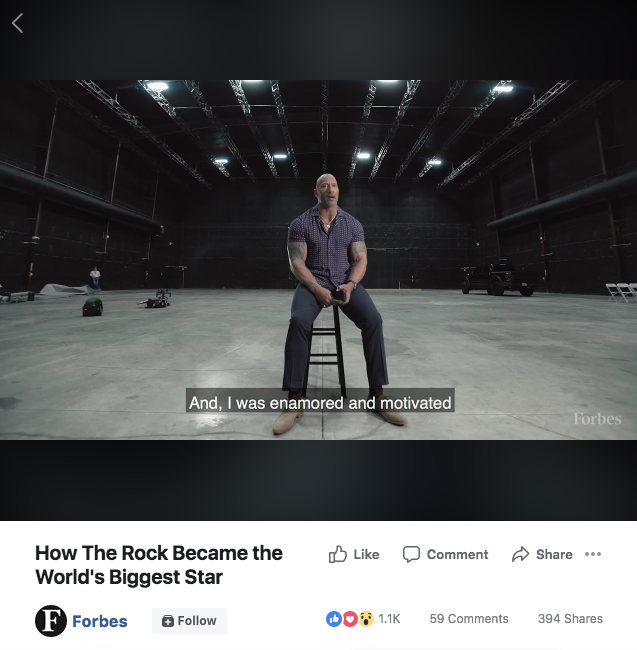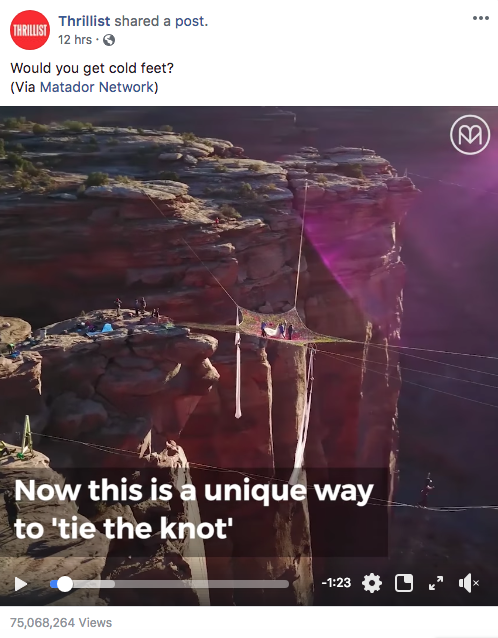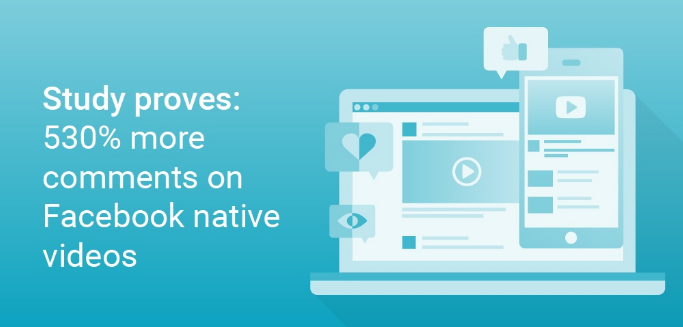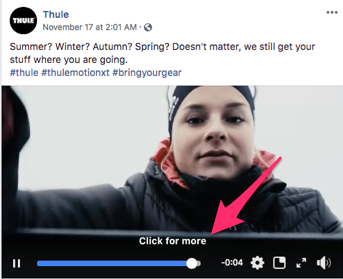Videos are a crucial component of your content marketing strategy. Once your videos are created, you need to distribute them on as many channels as possible.
With more than 2.2 billion monthly active users, it’s only logical for Facebook to be one of those distribution platforms.
Overall, this should be a winning strategy for your business. Here’s why.
According to research, 90% of consumers report that videos help them making purchasing decisions. And 64% of people say that watching a video increases their chances of buying something.
Further, 77% of businesses are using videos on their social media channels. Consumers are used to seeing this type of content from brands.
By using videos to improve your social media marketing strategy, your company will be able to:
- generate leads
- create brand awareness
- increase website traffic
- drive sales
But there’s a catch. You can’t assume that all your videos will be effective just because you published them on Facebook.
Your videos need to drive engagement.
If people aren’t engaging with your content, this strategy will not be effective.
Fortunately, there are plenty of ways for you to increase the engagement rates of your Facebook videos. That’s what inspired me to write this guide.
Use this as a reference to help you produce better videos moving forward and fix some of the videos you already shared. Here’s what you need to do.
Add subtitles
Usually, good audio is a key factor of a good video. Spoken words and other sounds can help you convey a message.
But if you’re relying on audio to drive engagement on Facebook videos, it’s going to be a problem.
That’s because 85% of videos on Facebook are watched without sound.
If people are speaking in your video, you need to add subtitles to the video. Even if your video doesn’t have people speaking, you can use subtitles as a way to narrate your video.
Explain what’s happening. Your video must be optimized for silent viewing.
Plus, Facebook videos automatically start playing on mute when users scroll through news feeds on both desktop and mobile devices.
If your videos require volume to get the message across, it could be why your engagement rates are so low.
Here’s an example of how Forbes Magazine used subtitles on this Facebook video:

Dwayne “The Rock” Johnson is speaking throughout this entire video. But even those watching with the sound off will receive his message.
Here are the detailed instructions for how to add closed captions on Facebook.
You can also do this manually with editing software such as:
- Adobe
- Final Cut Pro
- Animoto
Knowing that most people watch videos on silent on Facebook will change the way you produce content.
If you have videos that require audio, you could always add captions asking viewers to turn the sound on to experience the video in a better way.
Here’s an example from Tasty:

You don’t need to completely abandon audio. I’m not saying you should start creating videos without sound.
Just make sure they are optimized for silent viewing. Adding subtitles or captions is the easiest way to do that.
Publish a square format
Square videos have a 1:1 ratio. This format is much better for mobile users.
Why is this important?
Well, 92% of Facebook users access it on their mobile devices daily.
When square videos are played on these devices, they take up more real estate on the screen.
But engagement rates are higher on square videos on both mobile and desktop devices.

Furthermore, square videos have an average higher reach on mobile and desktop devices compared to landscape and letterbox formats.
The only time when a landscape video outperforms a square video is when it comes to the average completion rate on desktop devices.
Do you want people to watch your videos in full? Absolutely.
But remember, we’re trying to drive engagement.
Square videos still have a higher completion rate on mobile devices. If your desktop completion rate is the only metric that might suffer here, it’s still worth it to publish square videos.
It’s also worth noting that square videos get more average views per post on Facebook than landscape and letterbox videos combined.
Grab attention early
If people aren’t intrigued by your content within the first few seconds of your video, they won’t watch the whole thing and engage with it.
Avoid slow starts. Put your most interesting shots right in the beginning to pique viewers’ interest from the get go.
Here’s a great example of a video that Thrillist shared via the Matador Network:

As you can see, this video has more than 75 million views.
This perspective is amazing. It’s the type of shot that nearly makes you gasp when you see it.
Notice the progress bar. This is shown in the opening seconds of the video.
As a result, viewers will stick with the video because their attention has been grabbed early on.
This video also illustrates one of my previous points about subtitles.
If you look at the bottom right corner of the screenshot above, you can see that by default, the volume is muted. But you can still understand what’s happening from the captions on the screen.
I also like this example because it’s a shared post.
Not everything you publish needs to be your own. You can share someone else’s video on your page as Thrillist did here.
On the flip side, Matador Network benefits as well since its content is being shared.
The reason why you want people to share your content is it drives even more engagement when it’s viewed by more users. That’s what helped this video reach 75 million views.
Upload native videos
Native videos play in the feed, like in the examples you’ve seen so far. A native video will start playing automatically when a user scrolls to it on Facebook.
This is different from a video uploaded somewhere else and then shared on Facebook as a link, such as a link to a YouTube video.
If you’re not publishing native videos, it could be why you’re not satisfied with your current engagement rates.
Native videos have more comments than links to videos:

On average, native Facebook videos have a 110% higher interaction rate than YouTube videos.
They are also shared at a rate that’s 478% higher than links to YouTube videos.
As I said before, Facebook will automatically play videos on a user’s feed when they scroll on both desktop and mobile devices. But this happens only if the video is native.
Otherwise, you need to rely on the user clicking on the link you shared, getting redirected to another platform, and watching the content, and hope they engage with it.
That’s too many extra steps, decreasing your video engagement rates.
Target your preferred audience
Who is watching your videos on Facebook?
The engagement of your videos will depend on who sees them. You want to make sure your video content is relevant.
You’ll need to identify your target audience. Once you determine who they are, use that information to define the audience for your videos.
Before you publish anything, look for this option in the bottom left corner of the screen. Here’s what it looks like:

Once you click on this button, you’ll see a popup with the option to select your preferred audience and restrictions for the video.

With the preferred audience, you’ll be able to reach users based on factors such as the pages they’ve liked and their interests.
For example, you could choose interests like “swimming” or “baseball” depending on what type of business or industry you’re in.
The audience restrictions tab gives you the chance to narrow down users based on demographics such as:
- age
- gender
- location
- language
Making sure the audience is relevant will increase your engagement rates.
You can take this strategy one step further by publishing Facebook video ads. 71% of people say that the video ads they see on Facebook are relevant to them.
That’s because Facebook does a good job of giving businesses ways to target the right people with ad settings.
For example, you can use lifetime value to create a Facebook audience that converts.
Craft a striking title and description
You spent much time filming and editing the video. Time to publish it on Facebook, right? Not so fast.
You need to put the same effort into your title and description.
Learn how to increase clicks by mastering your headlines. The idea is to grab the attention of viewers and get them interested right away, before they even watch anything.
Descriptive videos will also increase your chances of being seen through organic searches on the platform.
There are more than 2 billion searches on Facebook each day. You definitely want your videos to be optimized for these searches.
I assume you’ll be using your Facebook videos on other distribution channels as well, which you should be. It’s a great idea to repurpose your content across multiple marketing platforms.
But your copy for these videos needs to be Facebook-specific.
Look at this data from Sprout Social about Facebook copy:

Furthermore, Facebook posts with 80 characters or fewer have 88% more engagement.
Facebook gives you a limit of 63,206 characters per post. You can experiment with a longer copy if you want.
But as you can see from the statistics above, fewer words and characters drive higher engagement rates.
Include a CTA
What should viewers do when they finish watching your videos?
If you don’t know the answer to this question, they certainly won’t have a clue.
Your Facebook videos need to have a CTA. That’s what’s going to drive engagement.
Here’s an example from Thule:

The CTA is a link to its website, trying to drive sales of the products showcased in the video.
That’s one approach.
But you can drive engagement by other means. It all depends on the goals of each campaign.
If you want to expand your reach and create brand awareness, you’ll want your videos to be shared on Facebook.
A potential CTA could be as simple as “share this video with your friends.”
Ask viewers to comment on it as well by ending the video with a question to spark a debate. All of these strategies will increase your engagement metrics.
Broadcast live
While you may not want to do it every day, live video streaming is a great way to boost engagement on Facebook.
With Facebook Live, you can have a more authentic interaction with your audience.
As you broadcast, they’ll be able to add comments and questions. This gives you the opportunity to respond to those users in real time.
When should you go live?

Late at night and late in the evening are the two best times to go live if you’re trying to drive engagement.
I’d say you can use this strategy about once a week.
Try to stick to a schedule, similarly to a TV show. If your audience knows you’re going live every Wednesday night at 9:00 PM, you’ll have more viewers.
Showcase your best videos
Not all your content is the same.
As someone who produces tons of blog posts, videos, and podcasts, I know this reality firsthand.
It would be amazing if everything you produced and published was perfect, but that’s unrealistic.
Some of your videos will be better than others. You know it, and your audience knows it too.
That’s why those videos have more views, likes, shares, and comments.
Feature those videos on your Facebook page. Here’s an example from The Wall Street Journal:

Usually, the most recent videos are displayed first.
But if a user navigates to your videos page on the left menu, you have the option to have your best videos shown ahead of your newest ones.
The idea behind this strategy is that you can hook people with your best videos.
Once they engage with that content, they’ll be more likely to watch your other videos and keep coming back for more in the future.
Conclusion
Your video content might be great, but it’s useless if nobody is engaging with it.
Since the vast majority of Facebook videos are played without sound, you need to add subtitles to optimize them for silent viewing.
Publish square videos. Your content should be native to be played automatically in everyone’s feed.
Start with your best content to grab your viewers’ attention early. Don’t slack when you’re writing a title and description.
Take advantage of the preferred audiences feature to make sure your videos are shown to relevant viewers. All of your videos should end with a CTA.
Go live. Highlight your best content as a featured video.
If you follow the advice I’ve outlined in this guide, you’ll see a major boost in engagement metrics for your Facebook videos moving forward.
What strategies is your company using to drive engagement on Facebook videos?
from Quick Sprout https://ift.tt/2UZFoJR
via IFTTT